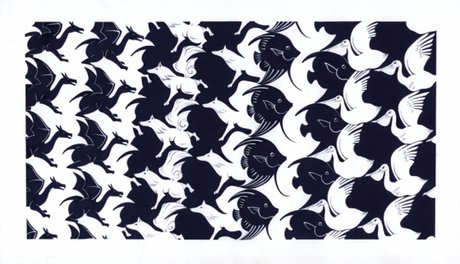In a Reversal the usual supposed cause-effect relation between objects or subjects are turned upside down. For example, it is supposed that the establishment of a permanent observation post increases the safety of recreational sailing. A Reversal could set up that the establishment of a permanent observational post rightly effective decreases the safety of sailors. The Reversal set up could lead to the idea that permanent observation gives sailors a misplaced feeling of safety, and also that observation can only timely detect sailors in difficulties, but doesn’t prevent accidents, nor solve them if happened.
- Reversals are applied to create opportunities to escape from patterns.
- Carefully designed Reversals are excellent thinking strategies in attempting alternative explanations for phenomenon in medical science, sociology and psychology.
One uncommon, unique and different arrow goes in the opposite direction of the rest of the group, symbolizing unusual nature, being a rebel or innovating with creative thinking.
As a somewhat weird hobby we collected some Reversals. Some will be known to you, some will astonish or even upset you. Many “collectors items” we gratefully derived from This Explains Everything -155 thinkers about the most elegant insights all time.
- The idea that team building can be stimulated by organizing a party with a lot of talk, fun, good food and drinks is totally wrong
Team spirit will evoke by successfully attaining goals in “weathering tests”. That teams after their trials exuberantly would party is wrongly interpreted as a condition for team spirit. Team members will become supportive only after overcoming an obstacle.
- We have a certain impression that important decisions in one’s life are taken consciously.
However, biologic research shows that important decisions are taken unconsciously, but that nevertheless our brains invent acceptable explanations regarding the token decisions (Terrence J. Sejnowski). Also, people don’t behave in a way because they are so-and-so, but make conclusions about what they are by observing their own behavior (Timothy D. Wilson). Traditionally, psychological problems come from the inner part of the clients. However, self-perception theory perspective suggests that people derive their inner feelings or abilities from their external behaviors. We don’t do who we are, but we are what we do.
- In what Nassim Nicholas Taleb calls “lucretan underestimation” current risk assesment methodologies are based on the worst event ever happened (the worst recession, the cruelest war, the worst unemployment rates), not on what could happen.
He argues that nature looks forward by anticipating to what perhaps would happen, by reserving extra capacity and building up strength. Redundancy is therefore not a defensive approach. See also the three earlier blog post about building robustness in systems here.
- Placebo’s – sugar pills with no effective medical working – are thought to have no influence on the body at all.
Sometimes patients given a placebo treatment will have a perceived or actual improvement in a medical condition, a phenomenon commonly called the placebo effect. Eric J. Topol suggests to use “placebo medication” as a therapy.
- Bibb Latané and John Darley, known from their confronting studies on bystander intervention and helping behavior, refute the proverbal truth of that “two heads are better than one”.
Two people are often less effective than one single person. The merely presence of some other beings prevent a single person are often than not to take adequate action in a situation.
Another examples of the inadequacy of “More Is Better” : “More ideas are better”. Actually, many inferior ideas will not even one really innovative idea. “More hands are better”: Many organisations try to solve problems by adding more resources (time, budget, workers, overseers), while fundamental redesign of the work processes could solve the problem. Often problems are solved by reducing the people involved.”Bigger is Better” or “Economies of Scale“: Many mergers, intended to improve efficiency and to reduce running costs, actually become counter productive.
- Normally it is assumed that romantic harmony between couples is the standard with the aim of copulating is the joint reproduction of offspring.
Huge conflicts between spouses are regarded as signs of dysfunction. However, David Buss posits a radical reformulation in a theory about sexual conflict: Sexual conflict or sexual antagonism occurs when the two sexes have conflicting optimal fitness strategies concerning reproduction, particularly over the mode and frequency of mating, potentially leading to an evolutionary arms race between males and females.
- “Dirt is not dirt, but only matter in the wrong place.” is another example of an Reversal which ensures that we will continue to question conventions.
- Some models of human behavior in the social sciences and many economics models assume that people are on average rational, and can in large enough quantities be approximated to act according to their preferences.
The concept of bounded rationality by Herbert Simon reverses this assumption to account for the fact that perfectly rational decisions are often not feasible in practice because of the finite computational resources available for making them. Humans are not rational actors but satisficing: the idea that in decision-making, rationality of individuals is limited by the information they have, the cognitive limitations of their minds, and the finite amount of time they have to make a decision.
- The idea that “there is a someone in my head” or ” some part of my head is responsible for …” is debated by David Eagleman.
In “Incognito. The Secret Lives of the Brain” he suggests that the brain contains divers and overlapping ways to handle the world. There are a lot of “someones” in our head, a representative democracy that functions due to competition between the brain parts of which we are not conscious at all. As such, the brain is subject to neural conflicts.
- Throughout centuries, it has been assumed that a perceived object doesn’t change under influence of an observer.
However, quantum physics, psychology and sociology has shown that this is not true. To expand this concept it is suggested that biology is the science about behavior of biologists, physics the science about behavior of physicists. This is a Reversal of empiricism, a theory of knowledge which states that knowledge comes only or primarily from sensory experience. Another Reversal of empiricism is the statement that perception without a theory is not possible. Theories like ideas, hypothesis, perspectives, perceptions, assumptions, etc. do have an important and fundamental role to acquire and enhance knowledge. Any observation takes place against the background of a theory, consciously or not. So called “Evidence-based Policy” is then more it’s Reversal: “Policy based Evidence”.
- Most software applications are designed to assist us with thinking tasks.
But in reverse, in the “Computional Brain” computer models constrained by neurobiological data can help reveal how – networks of neurons subserve perception and behavior – how their physical interactions can yield global results in perception and behavior, and how their physical properties are used to code information and compute solutions.
A last Reversion, to reflect on: To get a good idea the standard approach is to search for better ideas. A reversed approach is to get rid of a bad idea. Doing so helps to suppress simple, obvious but not effective attempts whereby a better solution can arise.


